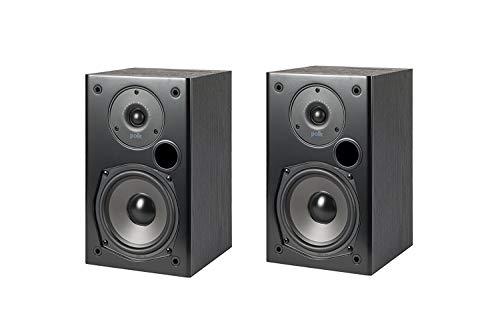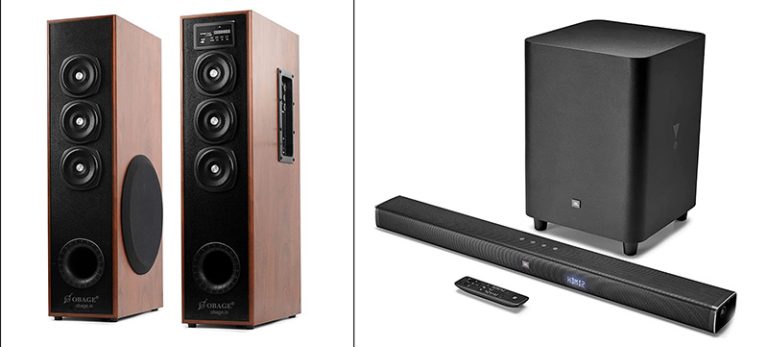Are Rear Speakers Really Necessary for Home Theater?
If you’re still in the planning stages for your home theater system and are trying to figure out how much you should budget for audio, you might consider whether it’s worth investing in rear speakers.
Rear speakers are not absolutely necessary but they do enhance your home theater audio. Placed behind the audience, rear speakers add depth to the sound and help create an immersive surround sound experience.

To help you decide whether you should buy rear speakers, let’s first understand the role they play in a surround sound setup.
Also read: Are Ceiling Speakers Good for Surround Sound?
Role of Rear Speakers in a Surround Sound Setup
Simply put, surround sound is audio that ‘surrounds’ you. Speakers are placed all around the room at different positions so that the sound ‘surrounds’ the audience and gives them a more realistic, three-dimensional sound experience.
A basic setup will have at least 3 speakers consisting of a center channel and left and right speakers. Most surround systems usually have 5 or 7-channel setups which usually consist of primary speakers (left, right, and center), satellite speakers (placed on your side and behind you), and a separate subwoofer.
Each speaker in this setup serves a unique purpose. Usually placed under the TV or screen, the center channel is the most important speaker here as 70 percent of the dialogue comes through this speaker.
Next, come the left and right speakers, which play the musical scores or sound effects. These are placed on the left and right sides of the screen. These 3 speakers generally focus on the foreground sounds.
Depending on the number of speakers, the left and right surround speakers are placed at the sides and behind the audience.
In a 5.1 setup, you would use side surrounds only. In a 7.1 set up the ‘surround back’ or rear speakers will also be included in addition to the side surrounds.
Here, the rear speakers will provide the background sounds, giving you the feeling of actually being there.
You can hear the same sounds the characters in the movie would hear, like you are part of the scene, rather than from a single direction. Like the feeling of something approaching from behind or perhaps another sound disappearing into the distance.
Rear speakers thus help create a sense of space and complete the surround sound experience.
Also read: Surround Vs Back Speakers – What’s the Difference?
Are Rear Speakers Really Necessary – How to Decide?
There are two main points you should consider when deciding if rear speakers are worthwhile for you-
Size of your Home Theater room
The size of your home theater room will determine how many speakers your space can actually handle.
For instance, if you have a very small room and your seating is against the wall, it may not be feasible to put rear speakers in addition to the side speakers. However, there are ways to get around this problem.
Larger spaces, on the other hand, require more speakers to fill the sound space. In this case, rear speakers would be a great addition, providing a whole new level of entertainment.
Your Home Theater Audio Budget
If rear speakers do not come in your budget, perhaps you can wait to add the rear speakers later. Since the center channel and left and right speakers are most important, it is better to invest in good quality speakers.
Another budget-friendly alternative is to opt for an all-in-one package. There are many such options available in the market. However, this may result in you sacrificing audio quality in order to get surround sound.
If budget is not an issue, purchasing rear speakers will make a perceptible difference to your sound quality.
Do The Brands Of Rear Speakers Need To Match With Your Front And Center Speakers?
No, it’s not absolutely necessary to match the brands you use for rear speakers with the front speakers.
Some argue that using different brands can be a plus point, giving you greater flexibility. You could select the brand of speakers based on which brands specialize in those types of speakers to get the best results- for instance, a brand that specializes in subwoofers.
Or you could accommodate rear speakers in your budget by choosing a high-end brand for your front speakers and a budget-friendly brand for the side and rear speakers.
However, for newbies to home theater audio, we recommend opting for the same brand for a simpler setup.
If you are planning to mix and match brands, do make sure that the front and center speakers are of the same brand for a seamless sound.
Remember most of the heavy lifting of the soundtrack, (mainly the foreground sound of dialogue and music) is done by these speakers. So it is important they are of good quality and well matched.
Rear speakers, on the other hand, only output 10-15 % of the sound, focusing on ambient sound rather than the main soundtrack. So it isn’t quite as critical to match the brand with the front speakers.
However, you should ensure your rear speakers can match the volume of your front speakers. Keep in mind that they should not be louder than your front speakers.
Another important factor to keep in mind is matching the wattage. Wattage essentially refers to how much power a speaker needs to output sound. The higher the wattage-the louder the speaker. All your speakers should have similar wattage in order for your sound system to work properly.
What is the optimum position to place rear speakers?
For ideal listening, rear speakers in a 7.1 set up, should be placed between 135 to 150 degrees behind the listening position. Place them a little higher than the front speakers to create ambient sound in the room.
Conclusion
Rear speakers can make a significant difference to your audio experience, giving you the full benefit of surround sound. If your budget and space allow it, we recommend you invest in these speakers to get a truly immersive experience with lifelike sound.





